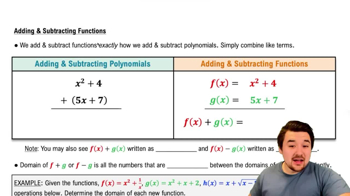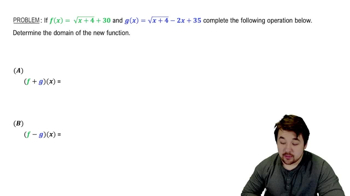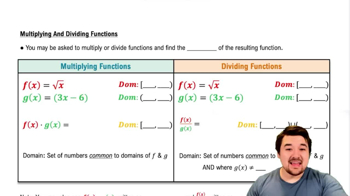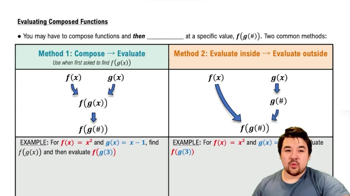Table of contents
- 0. Functions7h 52m
- Introduction to Functions16m
- Piecewise Functions10m
- Properties of Functions9m
- Common Functions1h 8m
- Transformations5m
- Combining Functions27m
- Exponent rules32m
- Exponential Functions28m
- Logarithmic Functions24m
- Properties of Logarithms34m
- Exponential & Logarithmic Equations35m
- Introduction to Trigonometric Functions38m
- Graphs of Trigonometric Functions44m
- Trigonometric Identities47m
- Inverse Trigonometric Functions48m
- 1. Limits and Continuity2h 2m
- 2. Intro to Derivatives1h 33m
- 3. Techniques of Differentiation3h 18m
- 4. Applications of Derivatives2h 38m
- 5. Graphical Applications of Derivatives6h 2m
- 6. Derivatives of Inverse, Exponential, & Logarithmic Functions2h 37m
- 7. Antiderivatives & Indefinite Integrals1h 26m
- 8. Definite Integrals4h 44m
- 9. Graphical Applications of Integrals2h 27m
- 10. Physics Applications of Integrals 2h 22m
0. Functions
Combining Functions
Problem 87a
Textbook Question
Composition of even and odd functions from graphs Assume ƒ is an even function and g is an odd function. Use the (incomplete) graphs of ƒ and g in the figure to determine the following function values. <IMAGE>
a. ƒ(g(-2))
 Verified step by step guidance
Verified step by step guidance1
Step 1: Understand the properties of even and odd functions. An even function satisfies f(x) = f(-x) for all x in its domain, while an odd function satisfies g(x) = -g(-x).
Step 2: Identify the value of g(-2) using the property of odd functions. Since g is odd, g(-2) = -g(2).
Step 3: Use the graph of g to find g(2). Locate the point on the graph where x = 2 and determine the corresponding y-value, which is g(2).
Step 4: Calculate g(-2) using the value found in Step 3. Since g(-2) = -g(2), take the negative of the y-value found for g(2).
Step 5: Use the graph of f to find f(g(-2)). Locate the point on the graph of f where x equals the value of g(-2) and determine the corresponding y-value, which is f(g(-2)).
 Verified video answer for a similar problem:
Verified video answer for a similar problem:This video solution was recommended by our tutors as helpful for the problem above
Video duration:
3mPlay a video:
Was this helpful?
Key Concepts
Here are the essential concepts you must grasp in order to answer the question correctly.
Even Functions
An even function is defined by the property that its graph is symmetric with respect to the y-axis. Mathematically, this means that for any input x, the function satisfies the condition f(x) = f(-x). This symmetry implies that the function's values are the same for both positive and negative inputs, which is crucial when evaluating compositions involving even functions.
Recommended video:
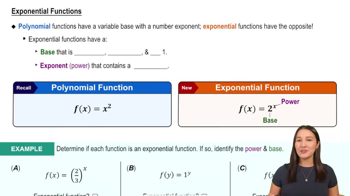
Exponential Functions
Odd Functions
An odd function exhibits symmetry about the origin, meaning that for any input x, the function satisfies the condition g(x) = -g(-x). This property indicates that the function's values for positive inputs are the negatives of the values for their corresponding negative inputs. Understanding this characteristic is essential when working with compositions that involve odd functions.
Recommended video:

Properties of Functions
Function Composition
Function composition involves combining two functions such that the output of one function becomes the input of another. In this case, we are looking at f(g(-2)), which means we first evaluate g at -2 and then use that result as the input for f. Mastery of function composition is vital for solving problems that require evaluating nested functions, especially when dealing with even and odd functions.
Recommended video:

Evaluate Composite Functions - Special Cases

 5:56m
5:56mWatch next
Master Adding & Subtracting Functions with a bite sized video explanation from Nick
Start learning
